Colorado and the Southwest
YOU HELPED US ACCOMPLISH SO MUCH IN 2024, AND THERE IS SO MUCH MORE TO COME!





YOU HELPED US ACCOMPLISH SO MUCH IN 2024, AND THERE IS SO MUCH MORE TO COME!




Communities in Arizona, Colorado, New Mexico, Utah, and beyond are eager for solutions to the many challenges facing our nation today. YOU are part of the solution. Together, we are not just dreaming of a healthier, more equitable, climate-resilient future—we are building it.
In 2024, Trust for Public Land made powerful impacts across the Four Corners states. From expanding Rio Grande del Norte National Monument in New Mexico to opening a pocket park in Denver’s Westwood neighborhood, TPL is getting the work done to strengthen communities and connect everyone to the outdoors.
Since 1980 in Colorado, we have protected 777,650 acres of lands and waters, completed nearly 750 parks, trails, and conservation projects, and connected over 275,000 people to close-to-home public lands. In 2023, we began working on a Community Schoolyard® in Colorado Springs that will become a premier model for
renovating schoolyards across the region. We launched an innovative pilot to create ecologically diverse micro-forests in communities lacking adequate tree canopy. And in 2024, we conserved almost 25,000 acres across the state.
We are thrilled to welcome our new President and CEO, Dr. Carrie Besnette Hauser. Prepared to propel TPL forward, she brings a wealth of experience in public policy, philanthropy, the outdoors industry, and community engagement. Most recently, she served as President and CEO of Colorado Mountain College. She has served on numerous boards, including the Colorado Parks and Wildlife Commission, Great Outdoors Colorado, and American Rivers. Carrie’s leadership will be instrumental as we amplify our efforts to expand outdoor access through commitments to equity, health, climate, and community.
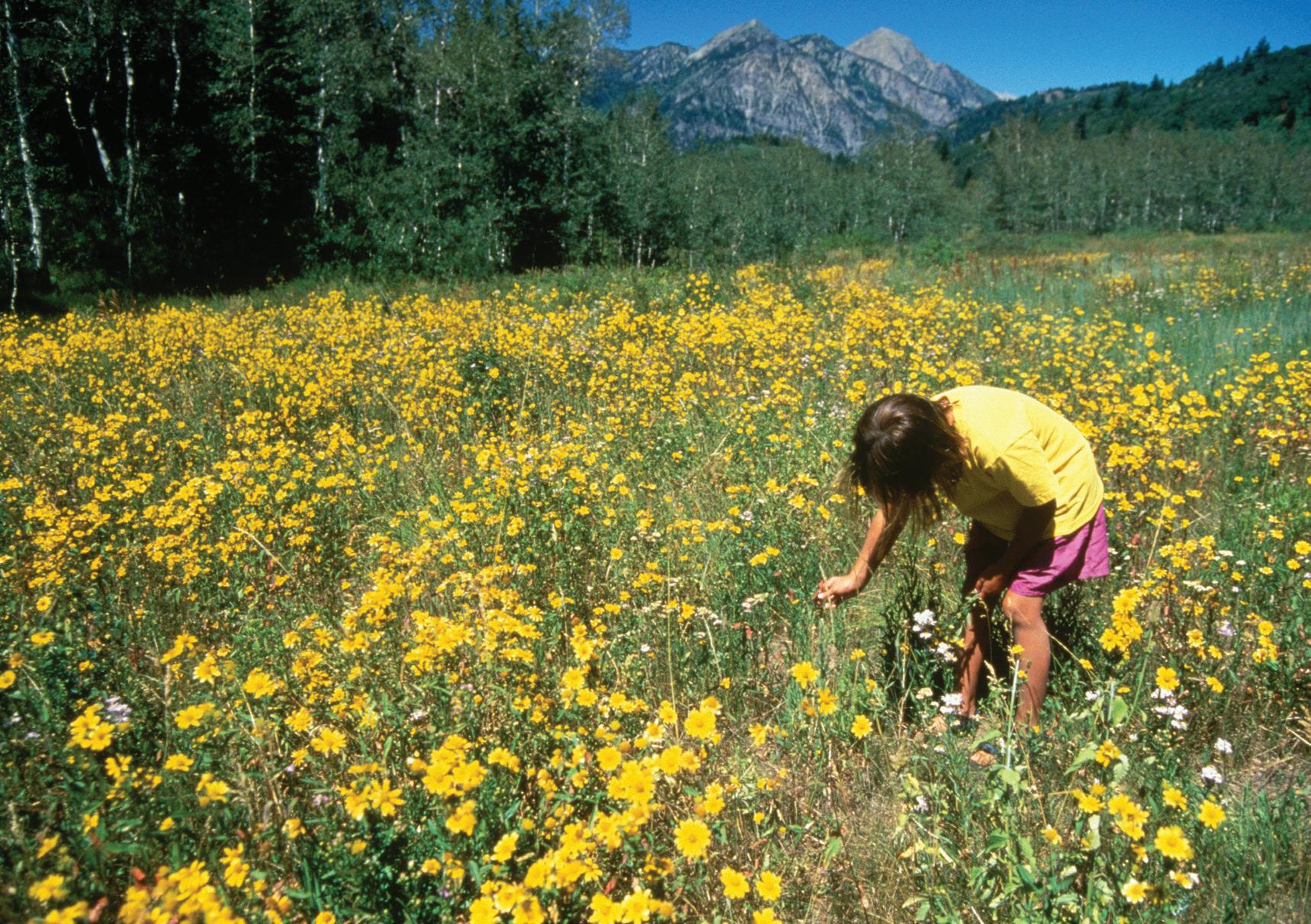
As TPL looks to the future, we remain committed to our vision of a world where every person can connect with the outdoors. We sincerely appreciate your steadfast support of TPL. Thank you for partnering with us on this journey.
James R. Petterson Vice President, Mountain West Region Colorado and Southwest Director
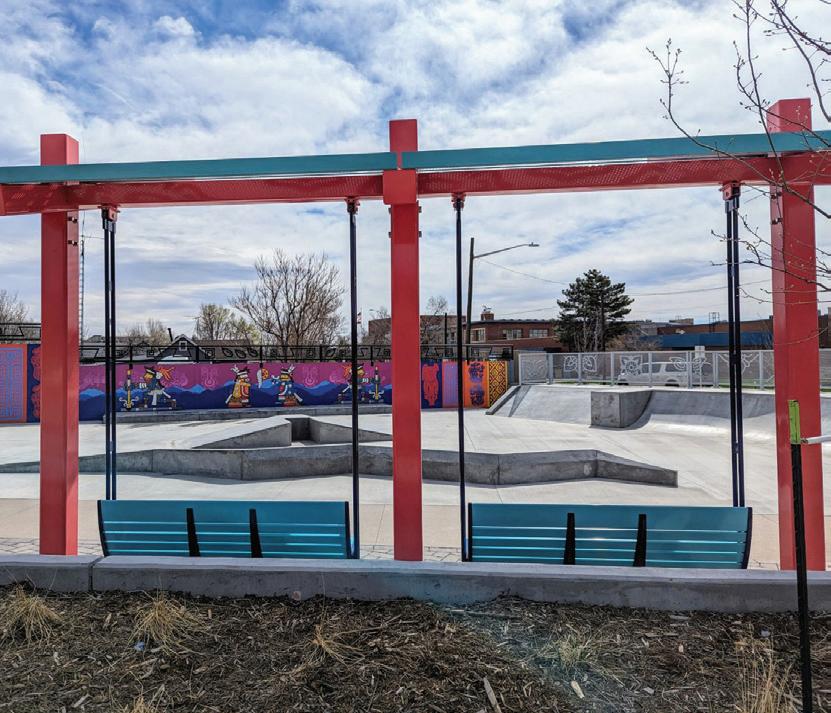
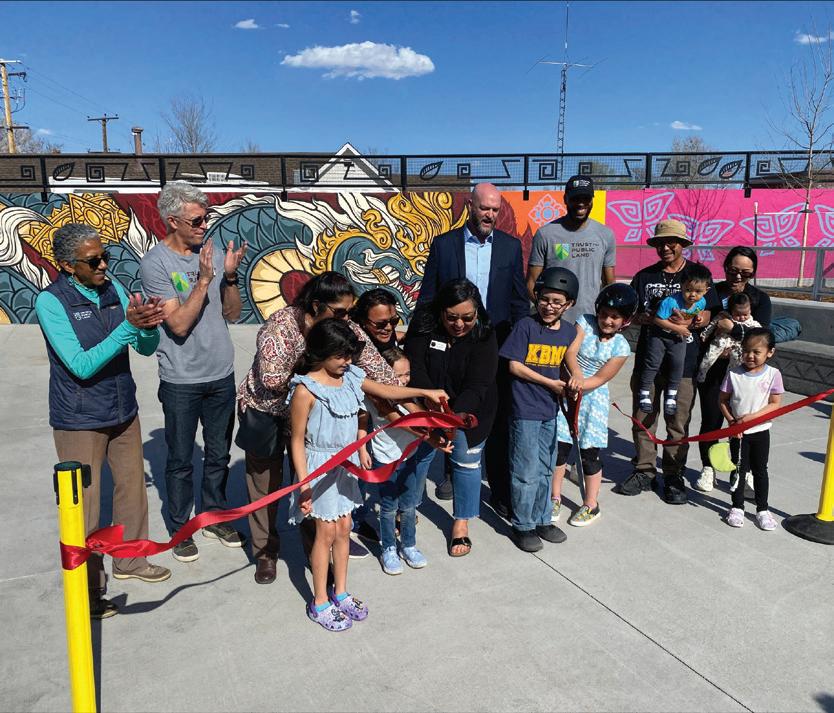

Access to the outdoors is a fundamental human need, but not all access is equal. Denver’s Westwood community reflects a national disparity: communities of color have 33.5 percent less park space, and typically lower-quality parks, than predominantly white communities. With a large, diverse Latinx community and a significant Asian American population, Westwood is home to the largest number of children under the age of 18 in Denver. But Westwood lacks the same access to quality parks and green spaces available in the rest of the city. This is why TPL proudly celebrated the 2024 spring opening of Westwood Pocket Park .
Once a defunct electrical substation surrounded by a six-foot security fence, the blighted lot was transformed thanks to TPL and Denver Parks and Recreation working together with the community. It is now a vibrant gathering place with a youthful edge that uniquely welcomes teenagers, filling a critical void in Westwood. At just under half an acre, the park—designed by and for neighborhood teens—packs a punch. Vivid and expansive murals, skate walls and ramps, a basketball half court, a custom shade structure, and ample seating chisel out a safe place for “just hanging out”—the number one activity teens told us they wanted a space for.
Collaboration and community engagement were central to the park’s design. We empowered resident-youth
experts to lead peer-to-peer interviews and public meetings and to drive the park’s vision and master plan. Our partners, Westwood Unidos, organized fiestas to gather local input, and Groundwork Denver’s Green Team led outreach to neighborhood youth, including conducting surveys and hosting youth-led community meetings. Together, third-generation Westwood resident, Mexican American/Aztec artist, and founder of D3 Arts, Santiago Jaramillo, and Denver-born, firstgeneration Cambodian American artist, Ratha Sok, designed the murals. The culturally inspired paintings pay homage to the community mural that adorned the security fence that surrounded the property for years.
Located at one of the Westwood’s most dangerous intersections, safety and connectivity were community priorities. We improved walkways to enable safe pedestrian access to Kepner Middle School and after-school programs at the Denver Housing Authority and J. Churchill Owen Boys and Girls Club, all steps away from the park. Westwood Pocket Park is TPL’s 12th project and one of three “park pearls” located along the Westwood Via Verde . This three-mile greenway is expanding a network of new and existing trails, parks, schools, bikeways, improved sidewalks, and enhanced alleyways that put more than 45,000 residents within a 10-minute walk of a park or green space.
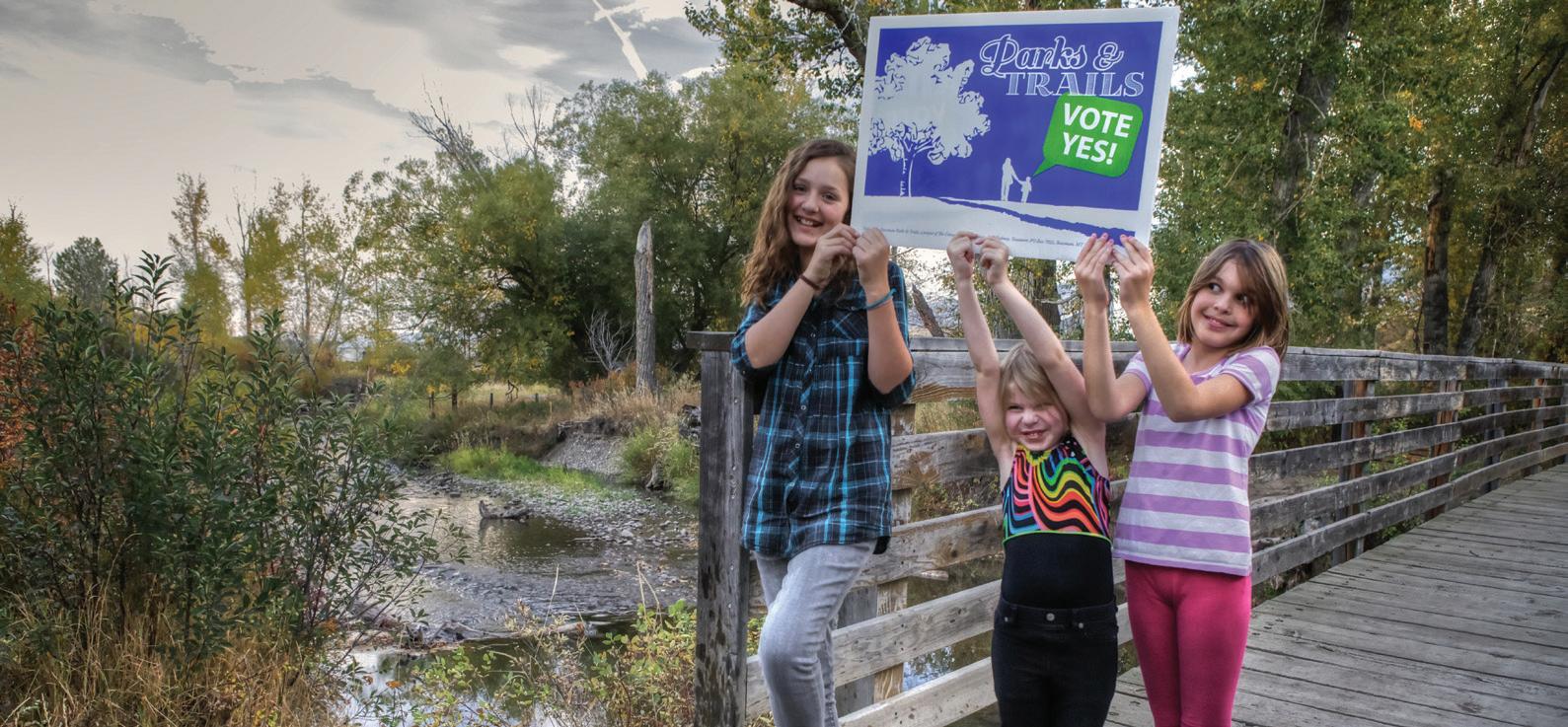
Passing ballot measures that deliver real systems-level change is no easy task. TPL’s Federal Relations and Conservation Finance experts are trusted advisors to state and local governments and community leaders on how to design, pass, and implement ballot and legislative measures to fund parks and conservation that reflect public priorities. Across party lines, the measures we support win approval in voting booths and on legislative floors, coast to coast and on Capitol Hill.
TPL joined a Colorado coalition of over 50 supporting organizations and businesses to extend and expand SB 126, Colorado’s Conservation Easement Tax Credit . A conservation easement is a legal instrument that prevents the development of a property while keeping it in private hands and provides a tax benefit to landowners. Sponsored by Colorado State Senators Faith Winter and
Perry Will and Representatives Meghan Lukens and Mike Lynch, SB 126 provides increased financial support for private landowners seeking to permanently protect their land.
The tax credit was extended until 2031, and the tax credit cap was expanded by $5 million annually The expansion aims to meet the current demand and broaden the scope of land conservation across Colorado. These incentives make it more appealing and feasible for private landowners to actively participate in land conservation.
With 60 percent of Colorado’s land in private hands, protecting vulnerable areas is crucial for building climate resilience, preserving working farms and ranches, safeguarding wildlife habitats, promoting biodiversity, reducing emissions, and ensuring that everyone has access to the outdoors.
It is thanks to the generosity of our donors that TPL is the national leader in securing voter approved funding for parks and land protection. Every $1 donated helps TPL unlock $2,000 in public funding to create parks and protect land.
In our nearly 30 years engaging in the parks and conservation arena, we have helped pass 649 ballot measures. Our 83 percent success rate translates to $94 billion raised in public funding for parks, land conservation, and climate change mitigation. Together, we are safeguarding our lands and building more resilient communities for the future.
The time to act is now. Contact us to make a difference today!
If your state or local government requires assistance designing, passing, and implementing legislation and ballot measures to establish public funding for parks, land conservation, and climate resilience efforts, please reach out to our Conservation Finance Program Directors for information:
West: David Weinstein, david.weinstein@tpl.org
East: Will Abberger, will.abberger@tpl.org
Flowing from the grasslands of Chino Valley to the Salt River near Phoenix, the Verde River corridor is teeming with cultural history, ecological diversity, and recreational opportunities. Over 1,000 acres of land along the river’s headwaters surrounding the once prolific Del Rio Springs sat relatively untouched for decades, although the land was being marketed for a future residential development. TPL saw the amazing, untapped potential to connect more people to the river and strengthen communities along its route.
TPL approached Arizona State Parks and Trails with a proposal to create a state park that would weave together recreation, ecological protection, and cultural history. TPL led the acquisition of 734 acres to create the Verde River Headwaters State Park and conveyed the property to State Parks to manage and steward.
Our expertise in negotiating large-scale land deals and leveraging philanthropy was instrumental in acquiring the land through a public-private partnership. We worked directly with the sellers to negotiate a price below the appraised value. The Nature Conservancy supported the effort with a major grant, and the Nina Mason Pulliam Charitable Trust—a significant funder of Verde River protection and restoration—made a grant to TPL for project costs. These gifts helped leverage $6 million from the Arizona State Legislature through a capital appropriation for the new state park and $1.5 million from Yavapai County, the latter made
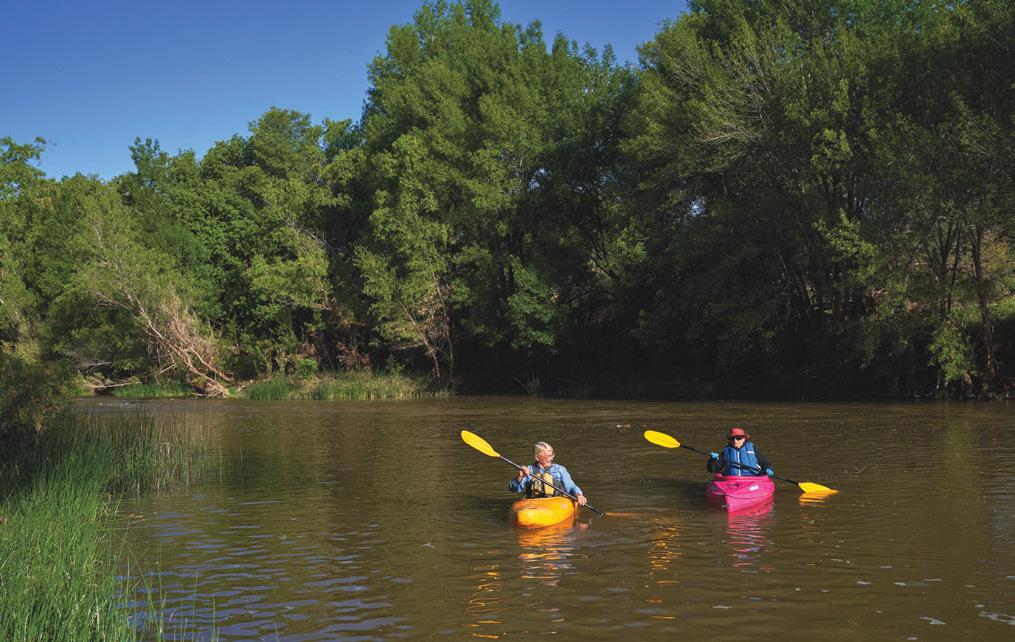
available through the federal American Rescue Plan Act of 2021.
The park is not just a natural reserve, but also a cultural heritage site. It offers unique opportunities to preserve and interpret the early history of Arizona and the Southwest. From Del Rio Springs, a railroad line provided the only source of water to several Arizona communities, including the south rim of the Grand Canyon. The river remains an important cultural and spiritual resource for the Yavapai-Prescott Indian Tribe and Yavapai-Apache Nation.
With nearly all 25 miles of the upper Verde River under public ownership, the new state park will deliver immersive outdoor experiences, including camping, hiking, biking, birding, and horseback riding. An abandoned rail bed will be developed into an expansion of one of Arizona’s few rails-to-trails projects, the Peavine National Recreational Trail. The town of Chino Valley was a strong advocate for this project, which will increase outdoor recreation tourism and generate economic benefits in the town.
This stretch of river is now being proposed for federal Wild and Scenic River status. With a Congressional designation, its ecosystems and water supply will be maintained and protected for future generations. TPL is actively working with partners to protect the entire river corridor.

In northern New Mexico, amber, sandstone, and cerulean hues sweep rugged plains anchored with looming volcanic cones and cut by deep, craggy canyons. Prehistoric footprints inscribe this land with etchings of human activity dating back 10,000 years. Archaeologists trace homesteaders to the area through the 1930s. These vast lands—home to the Rio Grande del Norte National Monument , established in 2013—appear illuminated against the sky.
Over the last two decades, TPL has protected over 25,000 acres in 10 land acquisitions in and around the national monument. We have been strategic in conserving high-priority lands such as the Taos Valley Overlook and Ute Mountain , as well as critical inholdings within the bounds of the national monument. This has enabled us to fortify the monument’s boundaries and increase access to its interior lands. Future expansion of the
monument—which is awaiting legislation—will increase recreational opportunities for millions of visitors who travel to the area to hunt, mountain bike, camp, and whitewater raft, and bolster the region’s recreation economy that supports and strengthens its people and surrounding communities.
Alongside high-value recreational opportunities, these lands are home to critical wildlife habitat. The successful land protection effort ends the threat of incompatible development that would diminish the monument’s viewshed, watershed, and wildlife. Rocky Mountain elk, bighorn sheep, mule deer, and pronghorn depend on the monument as a winter corridor between surrounding mountain ranges. The expansion will increase wildlife connectivity between the monument, Carson National Forest, Taos Pueblo, and Picuris Pueblo, ensuring protection for the region’s migration habitat.
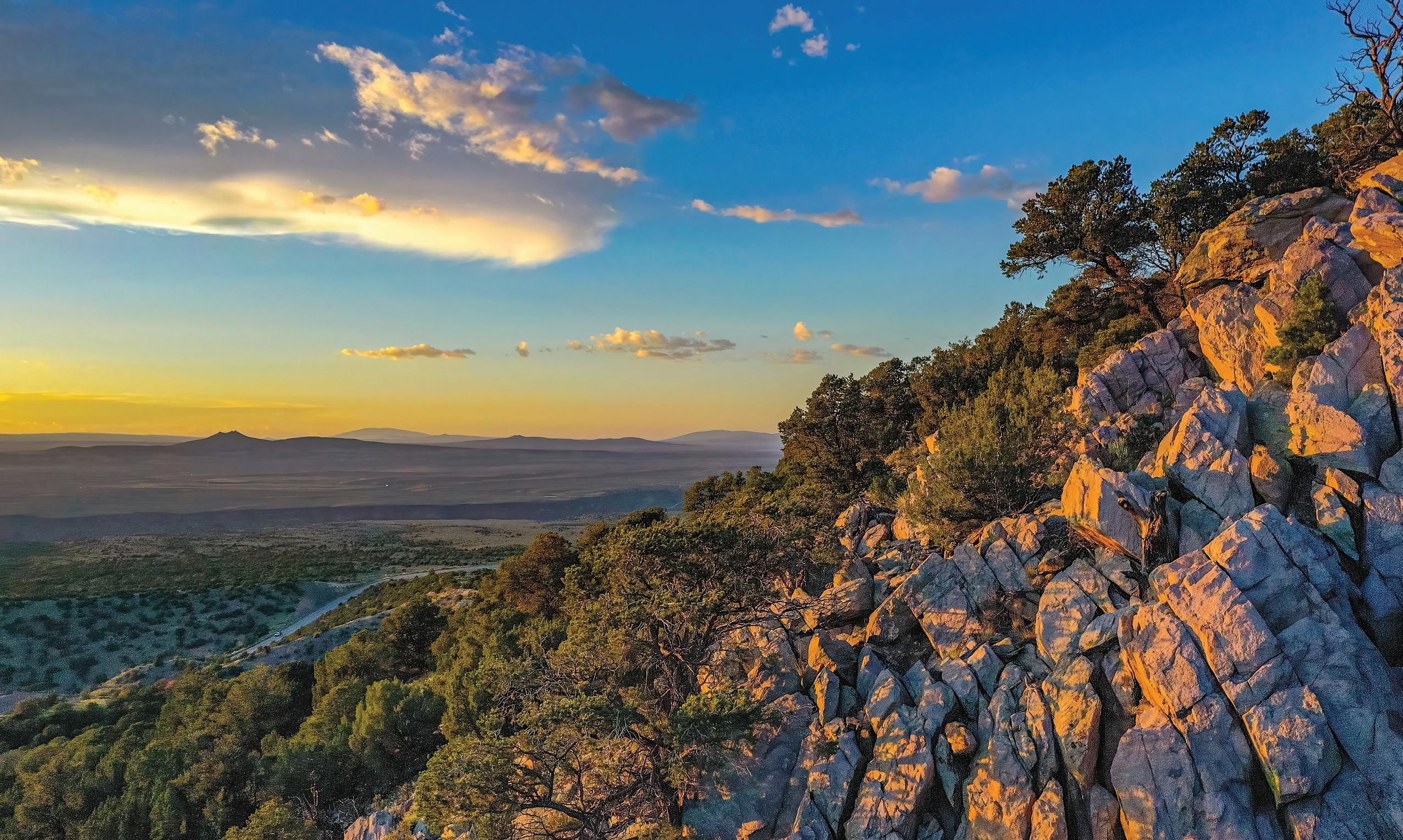
Our family has a great affinity and admiration for the people and land of Taos, NM. This land was purchased by W.H. Klauer over 100 years ago. His son, the late W.J. Klauer and the patriarch of our family, wished to see it preserved for public use while maintaining the open vistas and scenic character of Taos and the Rio Grande del Norte National Monument. We are so proud to have accomplished that mission today.”
Mike Klauer, representing the Klauer family
These projects would not have been possible without funding provided through the federal Land Water Conservation Fund (LWCF), totaling nearly $41 million. TPL is continuing to expand our conservation work in New Mexico to safeguard revered cultural lands and protect access to the outdoors.
In 2024, TPL conserved 3,750 acres of these breathtaking lands, conveying them to the Bureau of Land Management (BLM) for the impending expansion of the national monument. Future expansion of the monument—which is awaiting legislation—will increase recreational opportunities for millions of visitors who travel to the area to hunt, mountain bike, camp, and whitewater raft.
The recently acquired land had been owned for more than 100 years by one family. But Hispanic and Native American people have used the surrounding lands for many generations for hunting and grazing—from the 10,093-foot-tall Ute Mountain, the monument’s highest point, to the plummeting 800-foot-deep Rio Grande Gorge.
In an inspiring act of humanity and generosity, the family committed to honoring the wishes of its late family patriarch, who wanted the land preserved for public use. We worked with the family members to devise terms that met their vision and goals while prioritizing conservation needs.
The protection of these acres came to fruition thanks to a remarkable collaboration among TPL, the Department of the Interior, BLM, New Mexico elected officials, the Taos Pueblo, the Taos community, LWCF, the Klauer
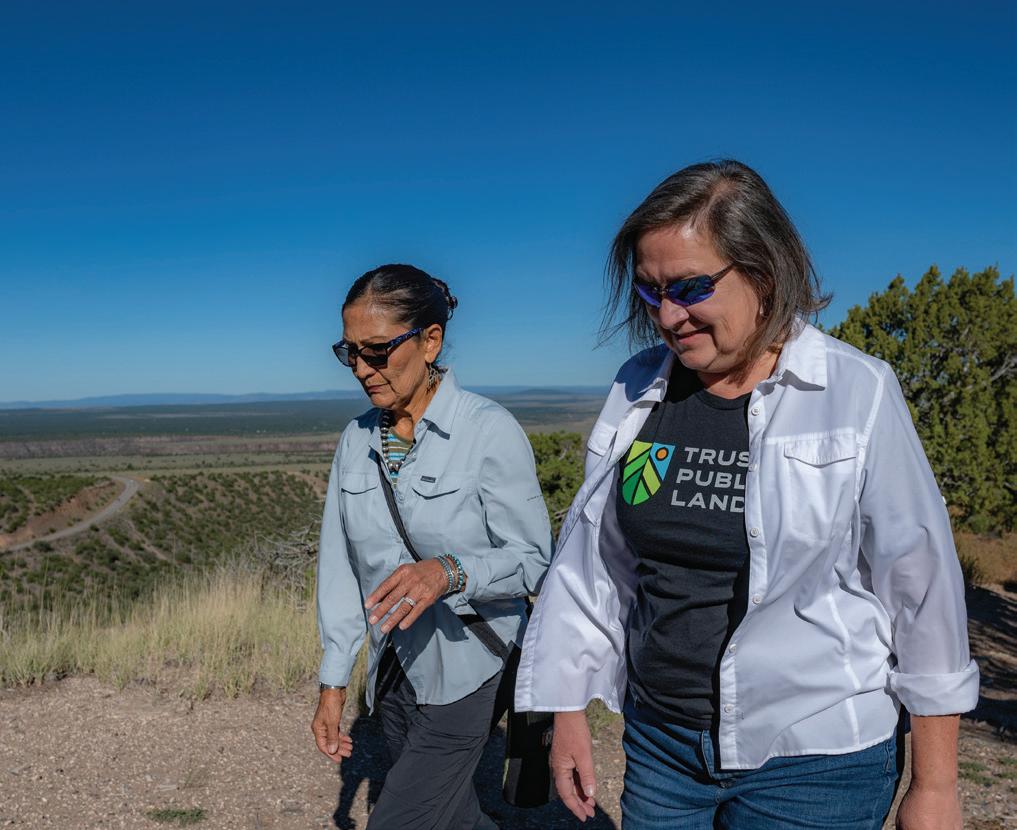
U.S. Secretary of the Interior Deb Haaland and past TPL CEO Diane Regas hike Rio Grande del Norte National Monument. PHOTO BY DAVE COX
family, and others. The collaborators gathered in Taos in summer of 2024 to celebrate the successful protection and future expansion of this important monument. U.S. Secretary of the Interior Deb Haaland, Senator Martin Heinrich, and Representative Teresa Leger Fernández were in attendance, alongside Taos Pueblo leaders and Taos community members.
The Land and Water Conservation Fund is a longstanding federal program that directs fees from oil and gas drilling to investments in parks and open space. TPL played a leading role in a coalition that secured permanent, full, and dedicated funding to LWCF. This means an automatic $900 million per year for the program and more access to nature for more people in every state. LWCF costs taxpayers nothing, and benefits everyone.

Open space is a critical common ground for Colorado Springs’ diverse economy and its community identity, which are both steeped in nature, ranching, and military institutions. The city draws people from around the country who come to connect with its recreational opportunities and breathtaking landscapes. But in this rapidly growing city, development is encroaching on open space and threatening the city’s fundamental livelihoods and core identity.
TPL has embarked on the long-term land conservation of more than 80,000 acres in Colorado Springs, in partnership with the U.S. Air Force, The Nature Conservancy, and Palmer Land Conservancy. Together, we are advancing SOAR (Security, Open Space, Agriculture, and Resiliency), which aims to limit encroaching development. Conservation will focus on high-priority open space necessary to preserve spacious views of the eastern plains, safeguard wildlife connectivity and important ecosystems, enhance climate resilience, maintain the safety and effectiveness of military installations under the U.S. Department of Defense, and secure local economies. Where feasible, we will create public access to quality outdoor spaces, especially in communities historically excluded from nature and outdoor recreation.
SOAR will demonstrate that conservation, agriculture, and military interests mutually benefit from land protection, and in turn, so do community members. All 80,000 acres protected through SOAR will help retain the diversity of Colorado Springs’ economy and the heart of its core identity.
Generations of cattle ranchers have maintained the rolling grasslands at Bohart Ranch, which in turn has sustained the local economy. The skies above Bohart, along with a remote runway on the property, are Air Force training areas for critical takeoff and landing protocols. In recent years, rapid growth has compromised training zones like this one.
Near the end of 2023, SOAR got off the ground with the acquisition of over 11,900 acres at Bohart Ranch , located roughly 30 miles east of Colorado Springs. This acquisition is the first phase in a multi-phase effort that will permanently conserve Bohart Ranch’s entire 48,000 acres.
With a significant area of Bohart now conserved, native habitat for over 200 plant species, 40 native mammals including bison and elk, numerous grassland bird species, and over 48 miles of streams will be protected. And skies will remain clear, enabling continued, safe Air Force training.
TPL’s Community Schoolyards® initiative has provided a strategic, common-sense solution to the nation’s park equity gap for close to thirty years. There are currently more than 90,000 public schools across America, and nearly all of them include a schoolyard. Yet across the country, few schoolyards are open to their communities outside of school hours. Even fewer schoolyards—less than five percent—are designed with quality green spaces and play features that school students and their greater communities need and deserve. Instead, many are hot, barren asphalt fields. These schoolyards are an underutilized public resource hiding in plain sight.
The schoolyard movement we began in New York City in the late 1990s is expanding across the country. Now, in Colorado Springs, we are making a $1.5 million investment to reimagine the schoolyard at Bricker Elementary School to unleash untapped potential and shrink the park equity gap. The student-led schoolyard design is inspired by the school’s vision statement: “All belong, all learn, all lead…to succeed.” What has long been a dirt playing field with outdated play equipment and no shade trees is being transformed into vibrant space for imaginative play, inspired outdoor learning, and nature-based climate solutions.
Our schoolyards are designed to improve health, boost academic achievement, combat inequities, and mitigate the impact of climate change. They are inspiring learning and play environments during school hours,
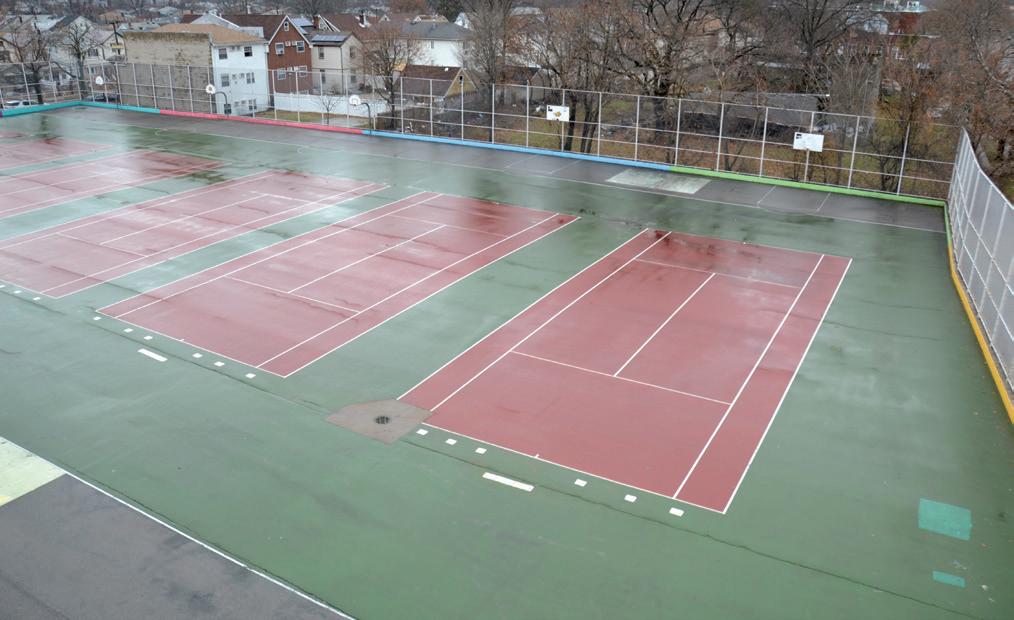
The reimagined and enhanced schoolyard here at Bricker Elementary will provide multitudes of new, creative possibilities that are meaningful for how teachers can design lessons and for how students can best learn. Hands-on lessons in a nontraditional classroom setting will relate to all subjects—students can study earth systems in a field or garden, math lessons can be taught by investigating shadows, language arts can be taught with writing creatively while engaging in nature.”
Crystal Crigger-Wildenstein “Ms. CW,” 5th Grade Teacher
and welcoming gathering spaces outside of school hours. They are packed with trees, rain gardens, nature-inspired play structures, outdoor classrooms, high quality athletic fields and equipment, and public art that reflects the rich cultures and communities the schools serve.
The Bricker schoolyard will be a demonstration project that Harrison School District 2 or any school district can tour as they plan their own schoolyard transformations. This flagship model will drive systemic change for scaling schoolyards across Colorado and the Southwest.

Through a groundbreaking partnership with the Bureau of Indian Education (BIE), TPL launched the national Tribal Community Schoolyards® program in 2023. We are privileged to be working alongside 29 Indigenous communities and nine Tribal schools . Working with BIE-operated schools in New Mexico, Nevada, Idaho, Montana, South Dakata, and Wisconsin, we are creating an equitable model to renew all 183 Tribal and Indigenous schoolyards across 23 states, serving 46,000 children.
This partnership seeks to redress the disparities in education, health, and climate. After centuries of colonial practices, Native children have the lowest high school graduation rates in the country, and one-third live in poverty. Native American people face some of the highest rates of depression, chronic health conditions, and suicide.
Through an inclusive and culturally sensitive process, Native people hold the visions for their schoolyards. Participatory design is a hallmark of TPL’s work. This
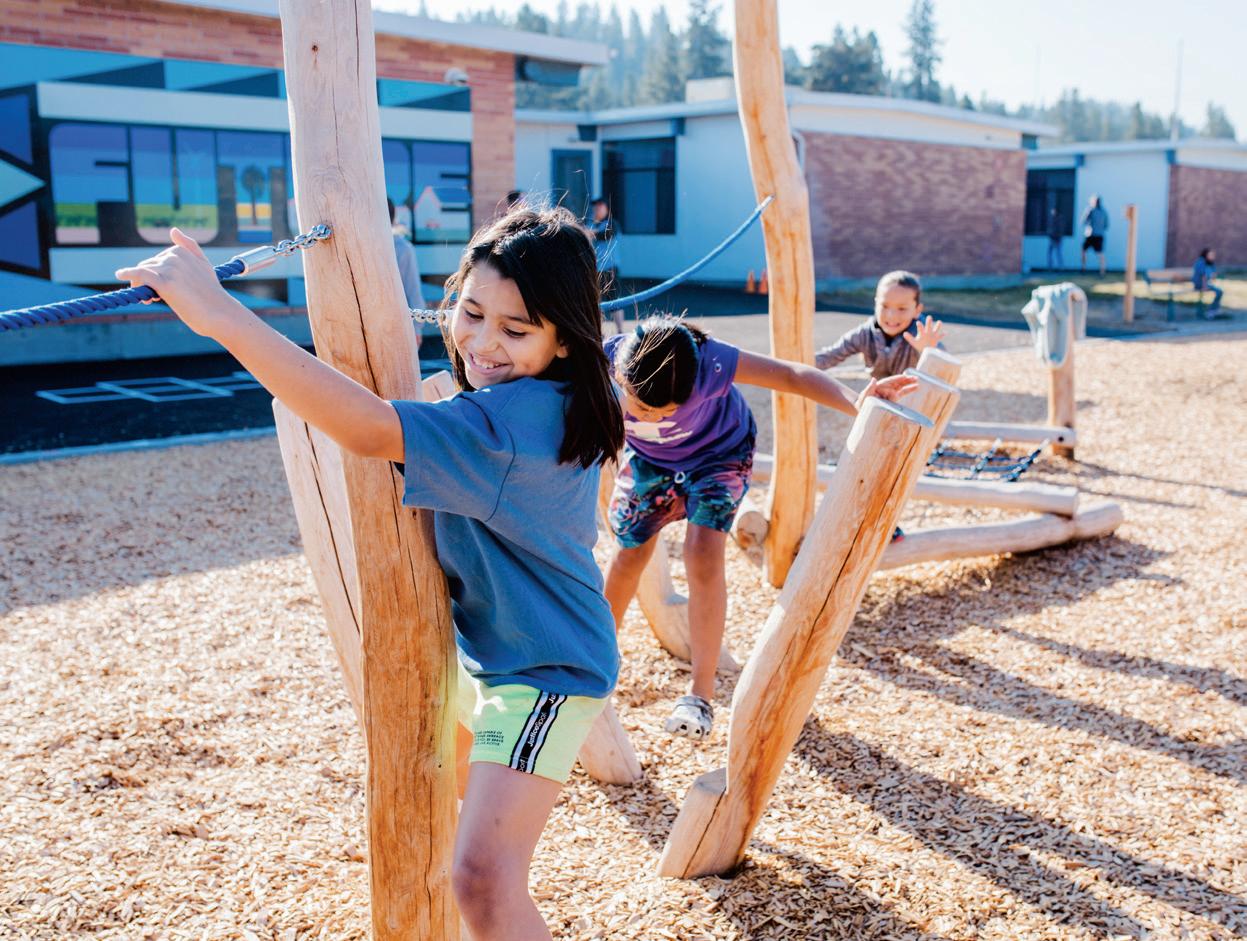
These schoolyards, which will take shape in tribal communities in states including Idaho, South Dakota, and Montana, will serve as culturally informed outdoor educational and recreational spaces that will benefit kids and their communities.”
Secretary of the Interior Deb Haaland, White House Tribal Nations Summit, January 2023
collective approach ensures that campuses will reflect local needs and values. Designs for the first three schoolyards, including Santa Fe Indian School in New Mexico, are infused with art, culture, and nature that will deepen and perpetuate knowledge of Native languages, customs, and practices. Some schools are incorporating canoes and tipis, longhouse classrooms, and woven sunshades crafted by Native artists. In learning gardens, students will cultivate fresh food and healthy eating habits. And rain gardens, swales, and shade trees will bolster resilience to flooding and intense heat.
The Tribal Community Schoolyards program began when U.S. Department of Interior Secretary Deb Haaland approached TPL in 2022 after learning of our partnership to transform a barren rural schoolyard in Chiloquin, Oregon. Until this effort in 2020, our schoolyard transformations had all occurred in urban communities. The Chiloquin Community Schoolyard was founded on collaboration with multiple underrepresented groups, including the Klamath Tribes, making it TPL’s first schoolyard collaboration with Tribal communities.
The program builds on decades of partnerships and conservation successes with Indigenous communities that embody a shared legacy of respect, collaboration, and achievement. In TPL’s 50+ years, we have partnered with 70 Tribes and Indigenous groups to protect or return 200,000 acres of ancestral lands to their rightful owners.
Long-time Coloradans, Kent Thiry and Denise O’Leary, received TPL’s 50th Anniversary Trailblazer Award last year—given to people who are making a significant impact in connecting everyone to the outdoors. Kent and Denise made a generous philanthropic investment in our Colorado Conservation Finance Program. The program works at the state level and with counties, cities, and towns to create dedicated funding for conservation, parks, trails, open space, and climate resiliency. With their support, in the last three years TPL has partnered with local jurisdictions to secure over
Our work in Arizona, Colorado, New Mexico, and Utah is made possible thanks to the generosity of foundations, companies, and individuals like you.
Wildlands: Conserve our region’s most iconic and imperiled landscapes.
Trails Activation Fund: Expand America’s trail networks across urban, rural, and suburban communities.
Community Schoolyards®: Transform barren public schoolyards into vibrant green spaces for inspired learning, play, recreation, and outside-of-school-hours gathering for all.
Tribal Community Schoolyards: Scale a groundbreaking model to remake Tribal schoolyards into community hubs that redress disparities in education, health, and climate, and celebrate Native history and lifeways.
Leave a Legacy: Create an even bigger impact by making a gift through your will, trust, charitable giving annuity, charitable remainder trust, beneficiary designation, or appreciated assets.

$1.6 billion in public funds through successful voterapproved ballot measures.
What sparked your passion for the outdoors?
KT: The outdoors is like a magic potion. We both realized how much more alive we felt when we were getting outside, and it seemed that the same was true for most others. This became especially apparent living here in Colorado.
What inspires you to give to TPL?
KT: We have been so financially fortunate and have both long cherished time in nature. We are inspired by TPL’s work to protect public land for all. It will help ensure younger generations enjoy the same experience with nature that Denise and I have had access to.
What about TPL’s work are you most looking forward to in your community?
KT: We love TPL’s work passing local initiatives to provide for community investments protecting nature and establishing local parks with strong community ownership. Both areas lead to spectacular returns on investment, across the boundaries of nature, health, trust, and stewardship.
What changes in the world do you hope your philanthropy can make possible?
KT: The idea is not to just protect nature—it is to protect nature in a way that also builds community, builds a sense of accountability to our planet, and builds a sense of hope and resilience for the future.
Kent Thiry and Denise O’Leary serve and have served on multiple academic, foundation, and non-profit boards. They have made strategic philanthropic investments in securing a future where everyone can connect to a healthy, vibrant outdoors.
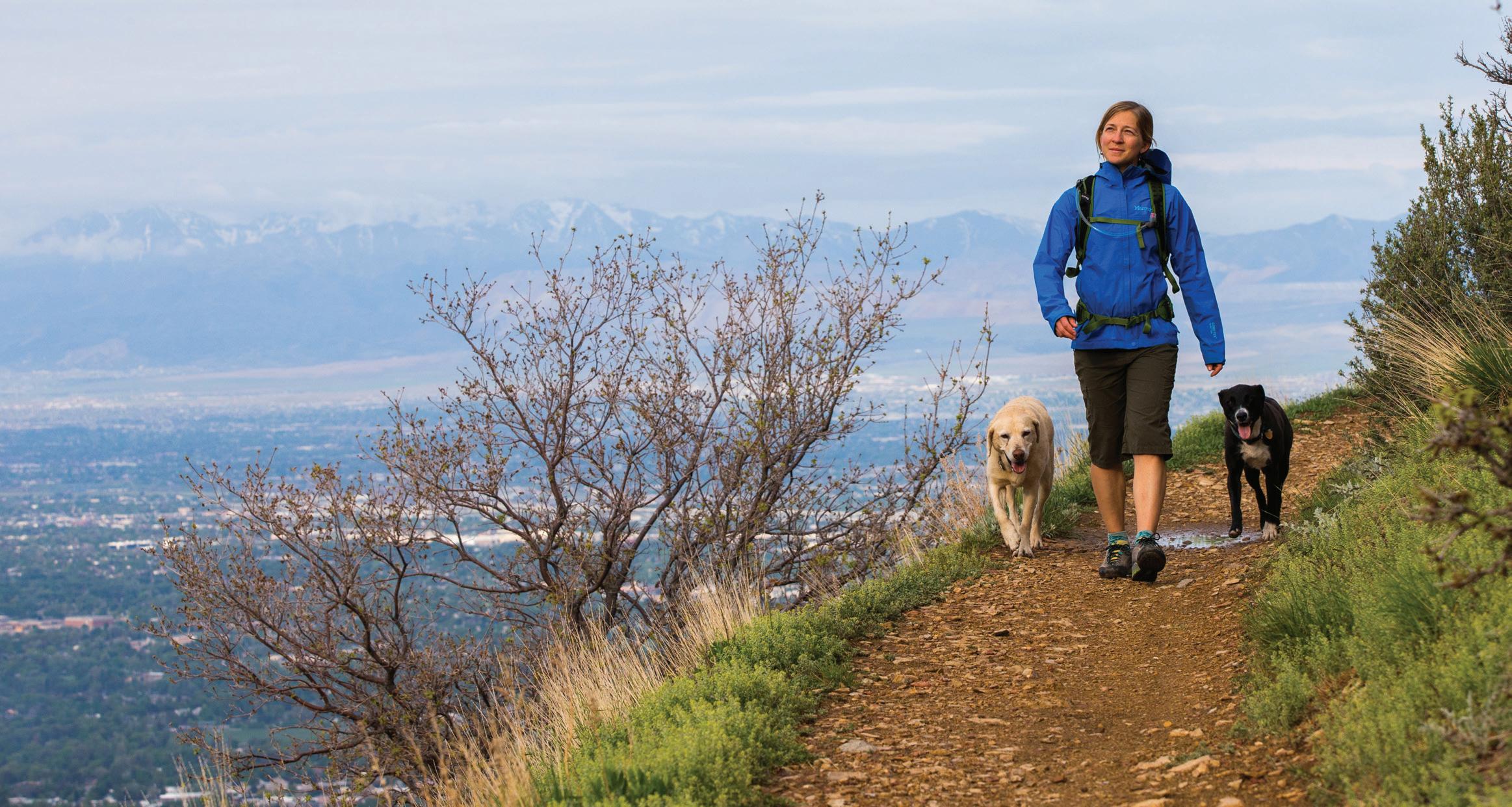
Beverly
Jonathan Adelman , Chair
Tara Alderfer
Kara Buckley
Dennis Carruth
Steve Coffin
Dana Crawford
Greg Felt
Anna Forkner
Allegra “Happy”
Scott Ingvoldstad
Peter Kirsch , Vice
Mike LaMair
Chris Miller
Kim Morss
Kimberley Sherwood